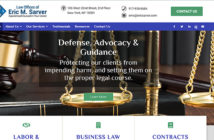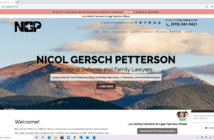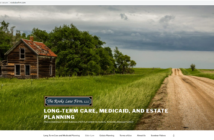This well-known attorney’s videos have generated $7 million in settlements and received 695,000 views.
YouTube is one of those channels that most attorneys do not understand. While a number of attorneys have used the platform to get more exposure for their TV ads, very few of them have used the platform as a tool to educate and connect with clients.
Moreover, among those who do use YouTube as a platform to create trust with their clients, even fewer are consistent in their efforts.
Gerald Oginski is an exception to this rule. I have never seen such a head start between one person in an industry compared to his peers. In fact, after reading this case study, I hope you will agree with me that Mr. Oginski has no peers in terms of attorney marketing on YouTube.
Despite extensive research, Mr. Oginski is the only attorney I found who displays the aptitude and approach necessary at this time to succeed on YouTube.
1. What is the purpose of your YouTube channel?
“Educate my ideal consumers and clients. To find information they are looking for.”
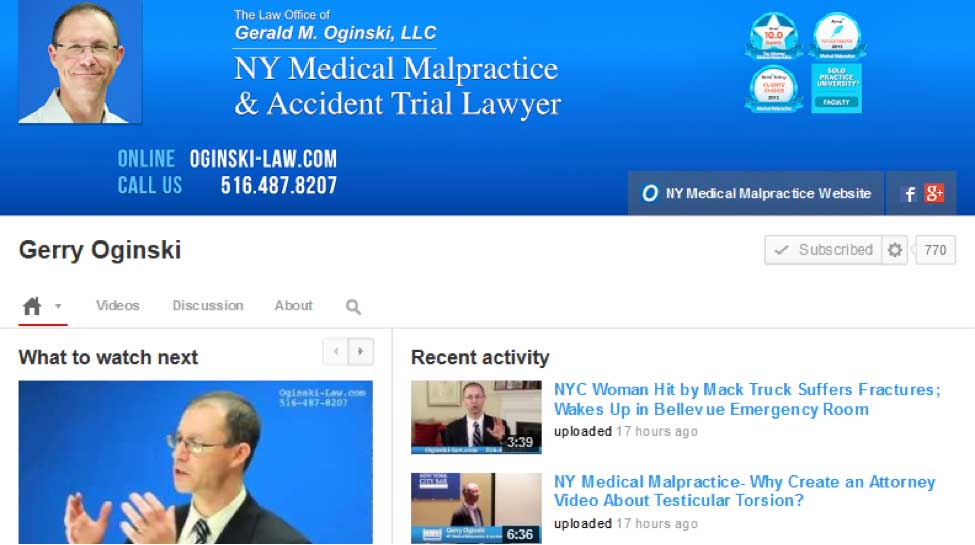
2. Why did you decide to create a YouTube channel over other forms of internet marketing?
“In 2007, I was a solo attorney who had been on my own for about 3 years, and my caseload was going downhill. I knew nothing about marketing. I knew nothing about how to generate new calls, except for referrals. And I thought I was doing a great job as a great attorney. What was remarkable was that I would be doing a great job for my clients, resolving their cases. Over a two-year period of time, I would look around and realize that the phone not ringing as much. I was not getting new cases in from my referral sources, so I realized I must be doing something wrong.
What was amazing was that at this time there was not a single attorney who was using video to educate consumers or provide clients what they needed to know.
I was the first attorney to create an educational message.
There were a couple of smart video companies who took their attorney TV ads and threw them up on YouTube. But I couldn’t understand why anybody in their right mind would voluntarily want to watch a 30-second ad of an attorney.
At that time I was learning about this concept called education-based marketing. I thought how great it would be if I could somehow figure out how to create a video that taught consumers something they did not know. Not give legal advice, but just teach them. I did not know anything about video or audio or lighting. I even had to ask my kids to figure out how to turn on the webcam on my Mac computer.”
3. What has been the greatest benefit from your YouTube channel?
“The greatest benefit is that I get calls and emails every single day from people who go online, find my video content, and call me up and say ‘Mr. Oginski, I just saw your video about this topic. Can I ask you some questions? I have a similar problem.’
I have received payment from many valid cases using this media. Which is absolutely remarkable. These are cases that turn out to be valid, which I have taken and done very well with. I get excellent results with [these cases].
I continue to put up video every day, and I am close to 1,000 videos. I do not do pay per click or anything like that. It is all organic results.” Author’s note: Mr. Oginski’s YouTube Channel LawMed1 has 695,343 views.
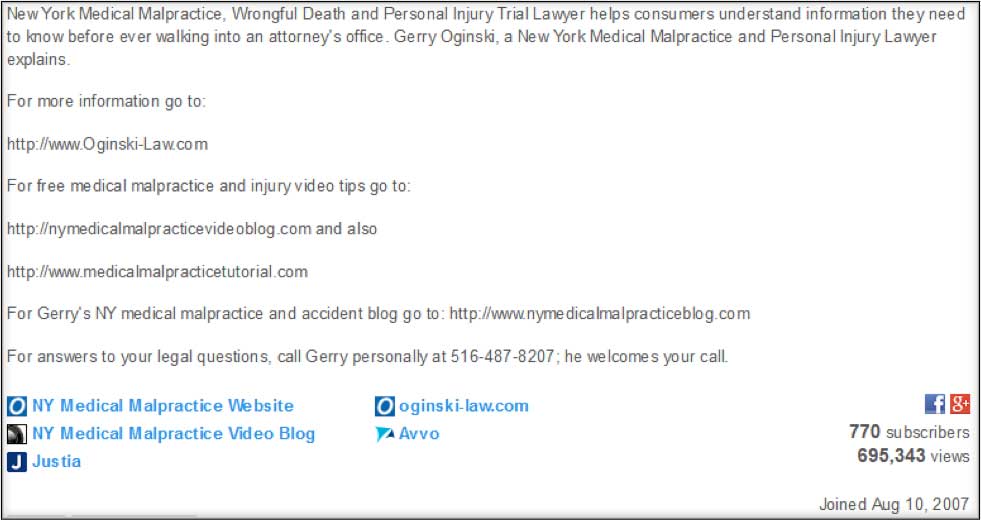
My videos have generated over $7 million in settlements. These are cases that I have taken in and successfully resolved them. I show attorneys the different cases that I have taken in, and why my videos drive cases.”
For example, “In July, 2013 there was an article in the New York Post that talked about a gentleman arrived from an international flight and collapsed and died in JFK airport in terminal 4. The article said, because it was a newly renovated terminal, the Port Authority personnel could not get access to him, because their slide cards did not work. There was a suggestion in the article that, because it was newly renovated and they could not get access that this gentleman died due to the delay of the Port Authority police getting to him.
I thought that was really interesting, so I created a video that talked about this story. But I did something way beyond just talking about the story. I created a video that not only mentioned the story, but also here’s what the family would have to prove in order to bring a wrongful death case in New York. I used the incident as an educational teaching point. I never mentioned the gentleman’s name. I didn’t mention it in the video, in the title, or in the description. Exactly 4 days later, I received a call and an email from the family of the gentleman who died at JFK airport.
It said, and this is the astonishing part, ‘I represent the family of the man who died at JFK airport. We found your video, we want you to represent us.’ Unfortunately, he did not have a case, but:
a. They went online to look for information
b. They found the video, even though I didn’t mention the victim’s name.
c. The email said we want you to represent the family, instead of we are talking to a few attorneys to see who can represent us.”
4. What is your greatest challenge in creating a YouTube channel?
“My wife and family were the biggest detractors. They said that nobody would watch my videos online. They thought I was wasting my time. No one in the country [was]teaching how to create video, and how to put video on YouTube. Nothing about audio or lighting. It was all trial and error. At the time I was also a full-time attorney.
It was very frustrating, very time-consuming. I would spend weeks trying to figure out how to do this stuff. The first video that I created was literally the worst video in creation. It was dark, it was grainy, and it was pixelated. However, the topic generated calls. The topic was How to Hire a New York Medical Mal-Practice Attorney.
I thought there is something about this that I think will work. What happened was that I had one secretary/paralegal, and when she left for the day, the calls would get forwarded to my cell phone. I might be on my car going somewhere, and all of the sudden I get a call, put it on speaker, and the first words out of the caller’s mouth were, ‘Mr. Oginski, I just saw your video about this topic, can I ask you some questions.’ Slowly over time, my family realized that I was getting all these calls from people who were watching these videos, and relating to what I was telling them.
5. What would be the one thing you would tell attorneys starting a YouTube channel today to do?
“Viewers are searching for information. And if you create educational information without legal advice, they begin to see you, they begin to hear you, and most importantly they begin to trust you before they ever pick up the phone to call you. The biggest hurdle a consumer has, if they have never met an attorney and have never interacted with an attorney before, is a trust hurdle.
And one of the best ways you can use video is to overcome that trust problem, and get someone to see and hear that you are trustworthy, that you have confidence in your material. That you know what you are talking about.
This changes the dynamics. Instead of the consumer coming in to interview you, to see if you are the right one, they have that mindset that says, ‘Hey, I like you. I like what you have to say, I want you as my attorney.”
6. Are there any special things that a lawyer needs to know about YouTube that other businesses might not think about?
“Every attorney must always stay within the ethical guidelines of his or her state. And it does not matter what media is being used. So if you are saying something in a TV ad you are clearly are going to follow the same guidelines in a YouTube video. My teaching is always, if there is a grey line, something you are not sure about, never say it. Stay away from the gray zone. You never want to disparage anyone, ever.
In a video, you never need to mention any one’s name. Neither the plaintiff’s name nor the defendant’s name. They are not necessary for teaching purposes. Even if you got a verdict in a case, names are not needed.”
7. What video technology do you use to create the videos? Do you have professionals create the videos, or do you create them yourself?
“I have multiple cameras and types of lights. However, for an attorney who is starting out my best recommendation is to start with a mid-level camcorder that has a remote control. I recommend the Canon Vixia line of cameras. Do not buy the most expensive one with the most bells and whistles. You don’t need it. You can always upgrade later
You must have a set of external lights, and you must use an external microphone. Never rely upon the microphone in the camera. I always say that it is not the equipment that matters; it is the content that encourages the viewer to pick up the phone and call. Because if you do not have the content is correct, and your presentation is not done well, then it does not matter what equipment you use.”
Takeaways
Part of what makes Mr. Oginski such an amazing person to discuss video marketing on YouTube is that his approach is so radically different from the vast majority of attorneys. Most attorneys are not there to educate and help the consumer understand legal matters.
Mr. Oginski provides the quality videos that help his listeners decide if they can use his services or not. This focus on education has provided him with the quality traffic he needs to bring qualified prospects who not only are interested in his services, but trust that the quality of his work will be superb.
Editor’s note: Mr. Oginski also helps attorneys create educational videos. Visit www.lawyersvideostudio.com.

